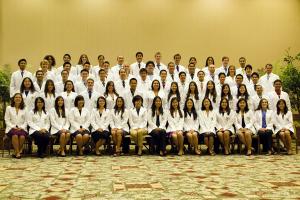Medical school to present physician workforce study results at summit
Physician Workforce Summit 2 will take place on Saturday, April 14
University of Hawaiʻi at MānoaContact:
Posted: Apr 12, 2012
Dr. Kelley Withy, UH Mānoa John A. Burns School of Medicine professor, will present the latest figures from the Physician Workforce Study at the Physician Workforce Summit 2: “Implementing Patient Centered Medical Home” on Saturday, April 14, from 8:45 a.m.-4:30 p.m. at the Sheraton Waikīkī Moloka`i Ballroom.
To see results of the 2010 physician workforce study, see: www.ahec.hawaii.edu/workforce.html.
Background:
The 2009 Hawai`i State Legislature created the study to assess the number of licensed physicians in Hawai`i who are currently treating patients and to estimate the future needs statewide for physicians based on Hawai`i’s population and the availability of practitioners in certain medical specialties areas (i.e., cardiology, etc.)
The assessment, led by the John A. Burns School of Medicine (JABSOM), is funded by a $60 fee imposed on MD licenses (licenses are renewed every two years). The fee is currently scheduled to expire this summer.
More than 250 Hawai`i physicians have registered to attend the second Physician Workforce Summit; at least one-fourth of them practice medicine in the critical shortage areas of the neighbor islands or rural O`ahu. Sixty-five percent of Hawai`i’s physicians are in solo practice or work in groups of five or less.
The summit is a working session for which physicians will receive continuing medical education credit. The educational focus is the patient centered medical home, a concept (coined in the 1980s by Honolulu pediatrician and JABSOM faculty member Dr. Calvin Sia) that has taken hold in many communities nationwide. The medical home is one location, usually a primary care provider’s office, where a patients’ medical history is held, and where a team works to address both the immediate health care needs of patients (including the scheduling of specialty appointments) and disease prevention, coordinating for example, screening tests like mammograms and keeping track of a patient’s care. The concept is popular because it reduces the number of costly emergency room visits, eliminates duplication of medical tests and promotes wellness.
However, implementing a medical home can be a costly investment for a doctor. (For example, launching an electronic medical record system at a practice can cost $50,000.) The summit will advise MDs about resources available to them to help.
“We are trying to let the doctors know about all the resources available to them so they can afford to make changes that make a big difference to their patients,” said Dr. Withy.
For more information, visit: http://jabsom.hawaii.edu

